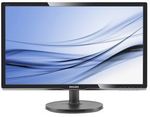Copy paste of description.
This Philips 216V6LHSB2 20.7" Monitor delivers vivid imagery on its LED display. It utilises SmartContrast technology for deep, rich black details so your favourite photos, videos and other multimedia are sure to look great.
The monitor has a Full HD resolution for high quality imagery.
It has a 5 ms response time for smooth, lag free operation.
You can connect to the monitor via VGA or HDMI.
It has a 3 star energy rating and an average consumption of 102 kWh per year.
The monitor is also compatible with 100 x 100 mm VESA mounts.
It has a compact, space saving design so it won't take up too much space in your workspace.


Centrecom currently have a 21.5" Acer 1080p on special for $99 as well if anyone is interested.